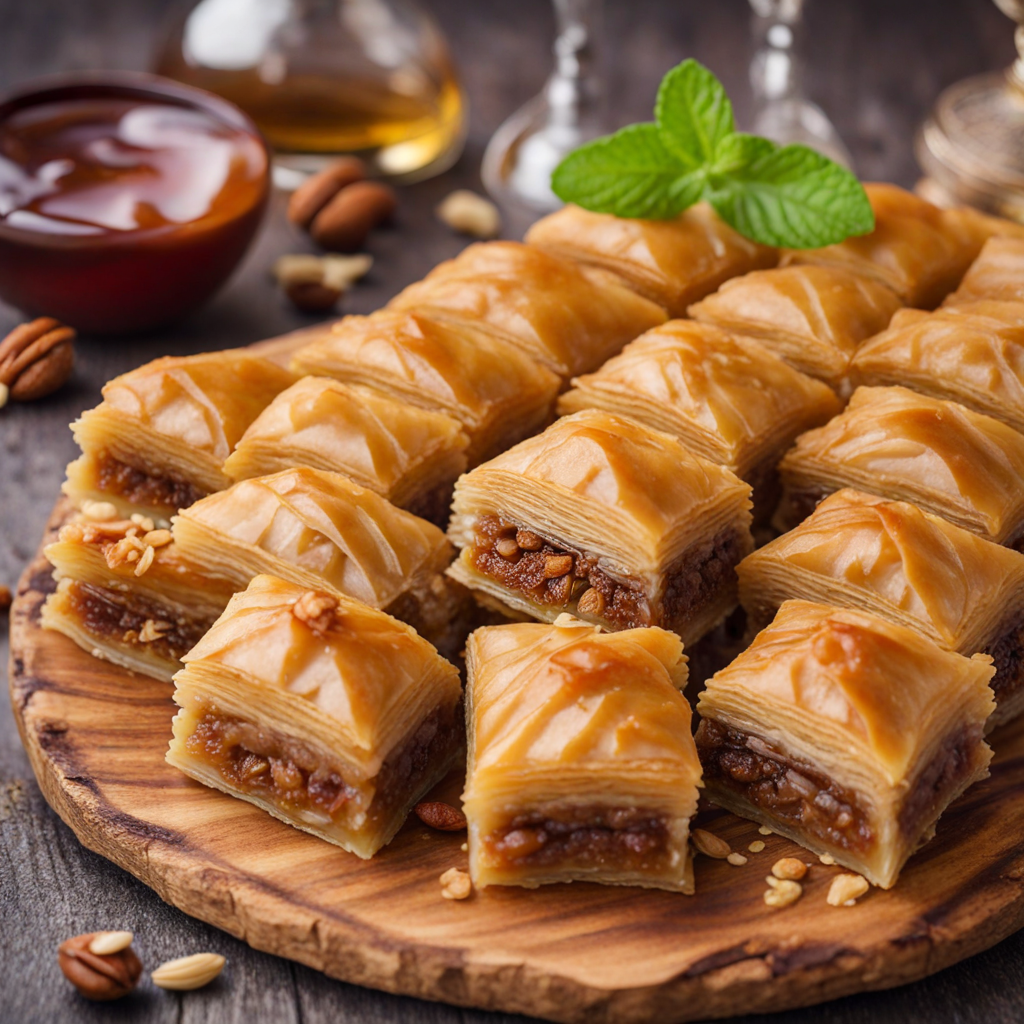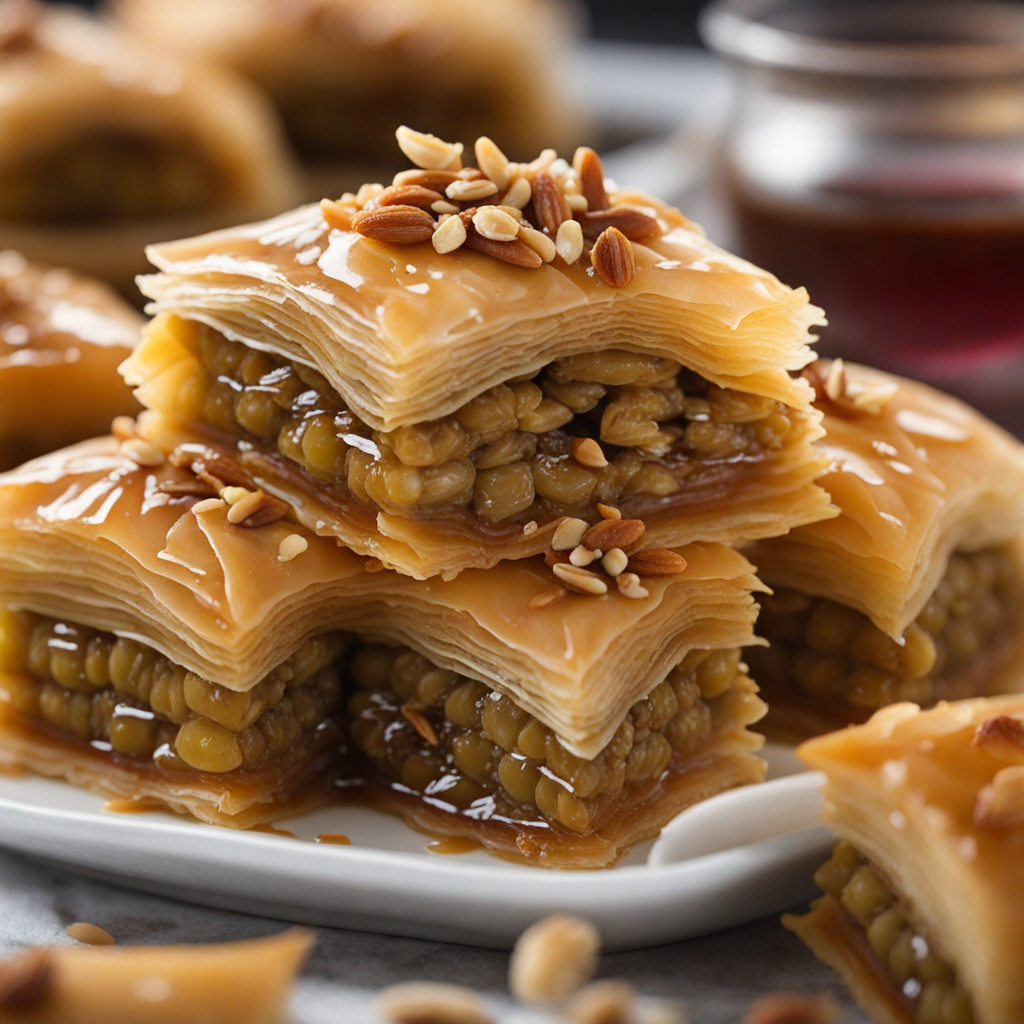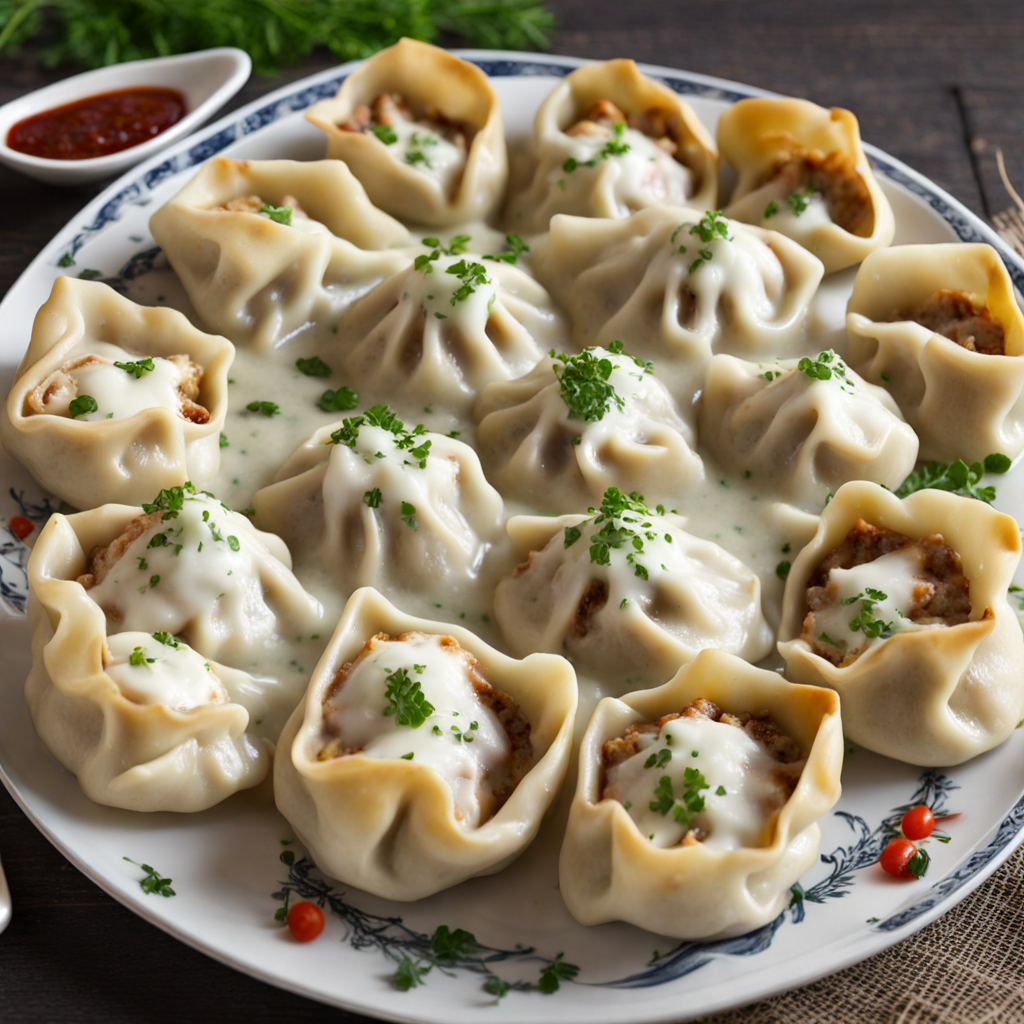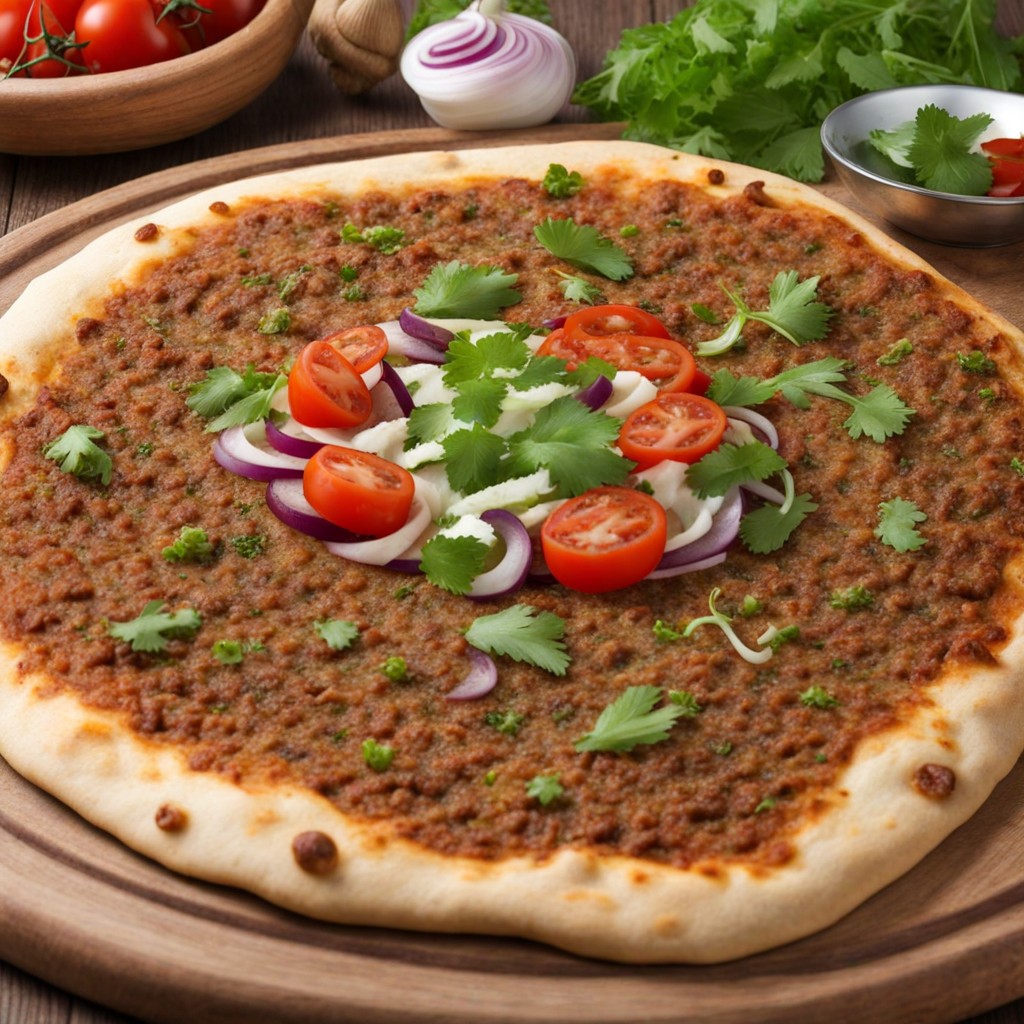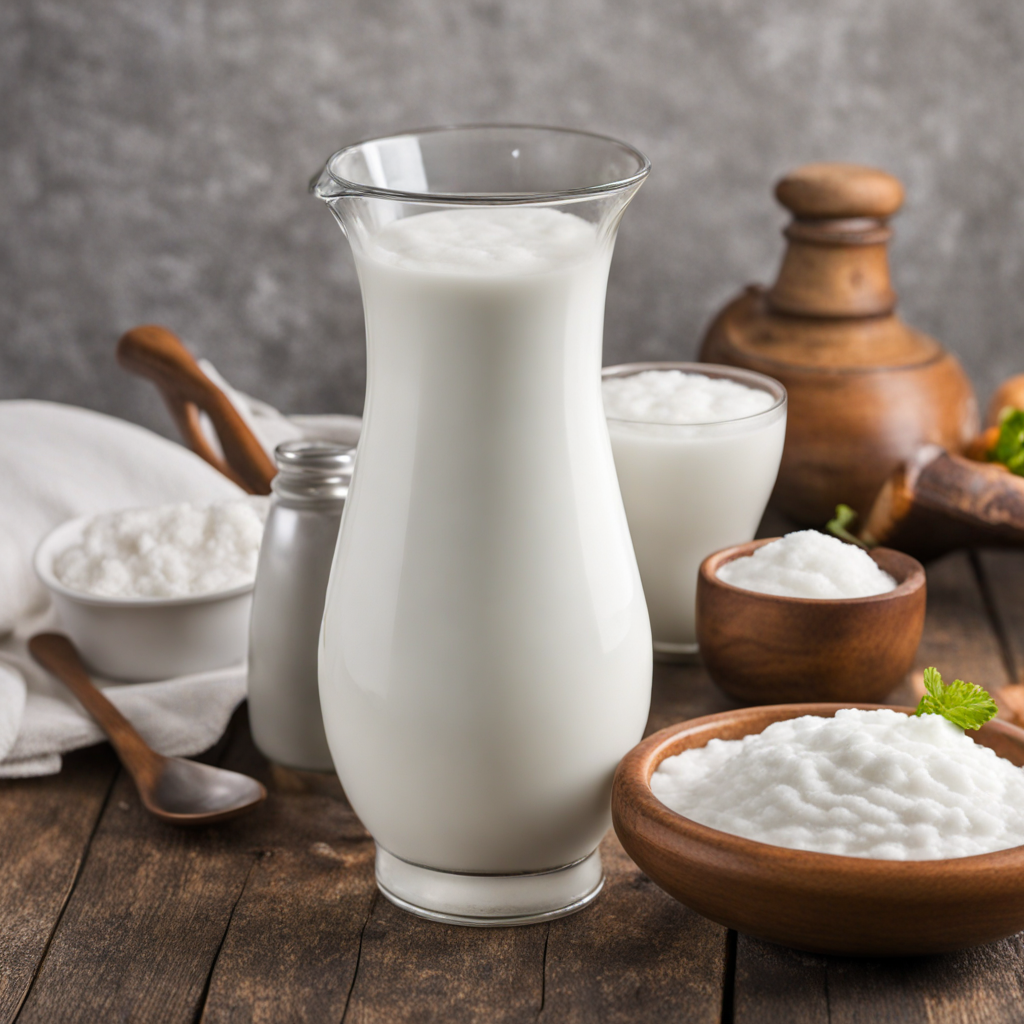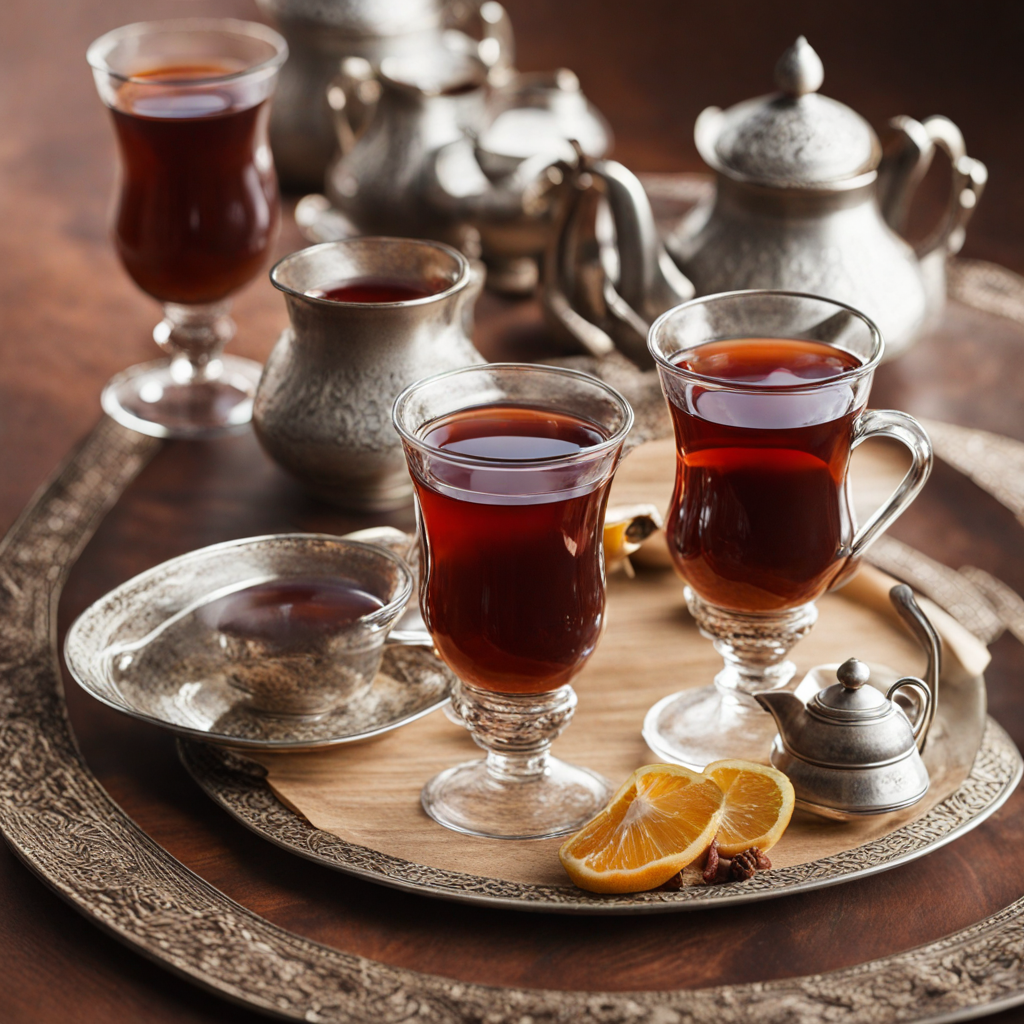Baklava
Baklava is a rich, sweet pastry that originates from Turkey and has become a beloved dessert throughout the Middle East and the Mediterranean. This delightful treat is made from layers of thin, flaky pastry known as phyllo dough, which is meticulously brushed with melted butter and layered with a mixture of finely chopped nuts, typically pistachios or walnuts. The combination of textures—from the crispness of the phyllo to the crunch of the nuts—creates a sensational mouthfeel that is both satisfying and indulgent. Once the layers are assembled, the baklava is cut into diamond or square shapes before being baked to golden perfection. The final touch is a generous drizzle of syrup, made from water, sugar, and often flavored with honey or citrus, which seeps into the layers, infusing the dessert with sweetness and moisture. This syrup not only adds a luscious sweetness but also enhances the overall experience with its aromatic notes, making each bite a delightful surprise. As you savor baklava, you'll discover an explosion of flavors that balance the nutty richness with the sweetness of the syrup. The warmth of the freshly baked pastry, combined with the aromatic spices that sometimes accompany the nuts, creates a sensory experience like no other. Whether enjoyed with a cup of Turkish coffee or as a standalone treat, baklava is sure to captivate your taste buds and leave you longing for more, making it a perfect choice for anyone looking to explore new culinary delights.
How It Became This Dish
The Rich History of Baklava: A Sweet Journey Through Time Baklava, a delectable dessert known for its layers of flaky pastry, nuts, and honey syrup, has enchanted taste buds for centuries. Although it is often associated with Turkish cuisine, its origins are a tapestry woven from various cultures across the Middle East and the Mediterranean. This layered pastry not only delights with its sweetness but also carries a rich history marked by cultural significance, evolution, and globalization. #### Origins: A Culinary Mosaic The roots of baklava can be traced back to ancient civilizations. Historians widely believe that its earliest forms originated in the Assyrian Empire around the 8th century B.C. The Assyrians are credited with creating a dish made of thin layers of bread dough filled with nuts and sweetened with honey. This concept of layering would later evolve into what we recognize today as baklava. The Greeks also played a pivotal role in the development of baklava. During the Byzantine Empire, the Greeks refined the recipe, experimenting with various nuts, spices, and sweeteners. The term "baklava" itself is believed to have derived from the Turkish word "bakla," meaning "to wrap," which reflects the method of preparing the pastry by layering and folding. With the rise of the Ottoman Empire in the 14th century, baklava reached new heights of popularity. The Ottomans, known for their rich culinary traditions, embraced and adapted the dessert, incorporating local ingredients and techniques from the diverse regions they conquered. The imperial kitchens of Topkapi Palace in Istanbul became renowned for their baklava, which was often served to guests of honor and during festive occasions. #### Cultural Significance Baklava is more than just a dessert; it serves as a symbol of hospitality and celebration in many cultures. In Turkey, it is a staple during special occasions such as weddings, religious holidays, and festivals. The act of sharing baklava is a gesture of goodwill, friendship, and love. In fact, the preparation of baklava is often a communal activity, where family members come together to create this intricate dessert, passing down recipes and techniques through generations. In addition to Turkey, baklava has found its place in the culinary traditions of various countries, including Greece, Lebanon, and Azerbaijan, each adding their unique twist to the recipe. For instance, Greek baklava often includes cinnamon and clove, while Middle Eastern versions might incorporate rosewater or orange blossom for a fragrant touch. This adaptability has allowed baklava to transcend cultural boundaries, becoming a beloved dessert that reflects the local flavors and traditions of each region. #### Evolution Over Time The journey of baklava through time has seen it adapt to changing tastes and ingredients. During the 19th century, as globalization began to take shape, baklava spread beyond the borders of the Ottoman Empire. With the migration of people and the exchange of culinary practices, baklava made its way to the Balkans, North Africa, and even into Eastern Europe. In the Balkans, baklava became a popular treat, often made with walnuts or hazelnuts, and sweetened with syrup flavored with lemon or orange. The dessert's popularity continued to grow, and it became a symbol of cultural identity for many communities. In countries like Bosnia and Herzegovina, baklava is a cherished part of national cuisine, often enjoyed during Ramadan and other celebrations. By the early 20th century, baklava had crossed the Atlantic, reaching the United States and Canada through waves of immigration. In North America, baklava became emblematic of Middle Eastern cuisine, with many restaurants and bakeries featuring it prominently on their menus. The dessert's sweet, nutty flavor and visually appealing layers captivated the palates of diverse populations, leading to its widespread acceptance and popularity. #### Modern-Day Baklava and Globalization Today, baklava is a global phenomenon, celebrated in various forms around the world. Contemporary chefs and home bakers continue to experiment with the classic recipe, introducing new flavors and ingredients. Variations have emerged, such as chocolate baklava, pistachio baklava, and even savory versions that challenge traditional notions of this sweet treat. The rise of social media has also played a significant role in the resurgence of baklava. Platforms like Instagram and TikTok have allowed food enthusiasts to share their creations, inspiring others to explore and innovate with this timeless dessert. As a result, baklava has become a symbol of culinary creativity, bridging traditional techniques with modern trends. In Turkey, baklava remains an essential part of identity and culture. The Turkish government has even sought to protect its culinary heritage by applying for UNESCO recognition for traditional Turkish baklava, emphasizing its historical and cultural significance. This effort highlights the importance of preserving traditional methods of preparation and the deep-rooted connections baklava has with Turkish culture. #### Conclusion Baklava's journey through history is a testament to its enduring appeal and significance across cultures. From its ancient origins in the Assyrian Empire to its status as a beloved dessert in Turkey and beyond, baklava encapsulates the complexity of culinary traditions and the interconnectedness of cultures. As it continues to evolve and adapt to modern tastes, baklava remains a cherished symbol of hospitality, celebration, and the sweet pleasures of life. Whether enjoyed at a family gathering, a festive celebration, or a simple afternoon tea, baklava is more than just a dessert; it is a delicious reminder of our shared culinary heritage.
You may like
Discover local flavors from Turkey


